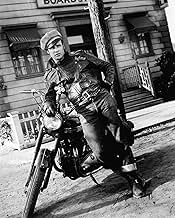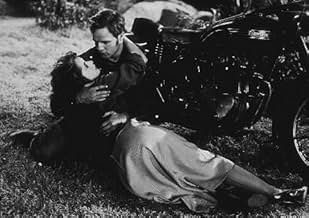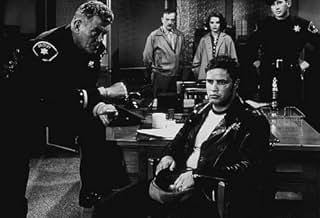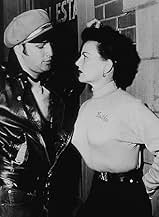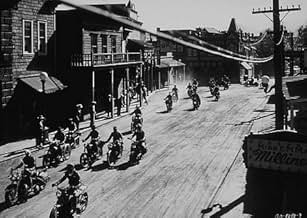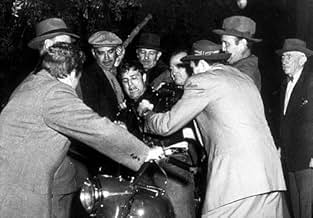IMDb-BEWERTUNG
6,7/10
18.245
IHRE BEWERTUNG
Zwei verfeindete Motorradgangs terrorisieren eine Kleinstadt, nachdem einer ihrer Anführer im Gefängnis gelandet ist.Zwei verfeindete Motorradgangs terrorisieren eine Kleinstadt, nachdem einer ihrer Anführer im Gefängnis gelandet ist.Zwei verfeindete Motorradgangs terrorisieren eine Kleinstadt, nachdem einer ihrer Anführer im Gefängnis gelandet ist.
Wally Albright
- Cyclist
- (Nicht genannt)
Chris Alcaide
- Deputy
- (Nicht genannt)
Don Anderson
- Stinger
- (Nicht genannt)
Robert Anderson
- Highway Patrolman at Sage Valley Race
- (Nicht genannt)
Robert Bice
- Wilson
- (Nicht genannt)
Handlung
WUSSTEST DU SCHON:
- WissenswertesThe Triumph motorcycle that Marlon Brando rides in the movie was his personal bike.
- PatzerAt the completion of the opening credits, when the view switches to the wide shot of the pack preparing to make a left turn, the lead bike (Johnny) already has the trophy tied to the headlight. Johnny isn't presented with the stolen trophy until a later scene at the races.
- Crazy Credits[Opening credit] This is a shocking story. It could never take place in most American towns -- But it did in this one.
It is a public challenge not to let it happen again.
- VerbindungenEdited into Heavy Petting (1989)
Ausgewählte Rezension
A peaceable town is taken over by motorcycle rowdies.
Despite the sometimes frat boy antics of gang members, the movie came across to audiences of the time as something of a 50's nightmare. For example, there's a small town taken over by motorcycle outlaws, a virginal girl (Murphy) surrounded by rowdies, a cop too meek to intervene, and a general breakdown of peace, quiet and conformity. In short, it's a challenge to the every day norms the famously inarticulate Johnny (Brando) is rebelling against. It's that sort of restlessness that takes the gang to the highway, and the excitement they seek. But it's also a nation recovering from the rigors of a big Depression and the disruptions of WWII. So the two are bound to clash. The movie may seem tame by today's graphic standards, but for the 1950's it was a barbarian assault against the decade's defining conventions. No wonder, the film was condemned in so many places.
Truth be told, Brando doesn't act so much as he poses. Nonetheless, it's an iconic pose in cap and sunglasses that shot him to the forefront of the decade's celebrated rebels. For example, catch how delicately he positions the sunglasses or how he slouches silently by while others cavort. Still, the movie really comes alive when Lee Marvin (Chino) and his gang hit town. He's the loudmouth opposite of Johnny, looking to knock him off his regal pose, which he tries in a well-staged fistfight. Then there's Mary Murphy's good girl, a perfect casting choice. When she flees down a darkened street just ahead of the motorcycle rowdies, I could feel frozen shudders all over the theater of that day. It was like small town America about to be ravaged. Of course, the tables are turned when some of the town's bolder elements form into vigilantes and chase Johnny down the same street. I guess violence, as they say, really is a two-way street.
Anyway, the movie's still a milestone worth catching up with. My only gripe is with the cheapness of the production. The town and the sets are bare bones, especially in the movie's latter half. Maybe that was intentional in order to highlight the story. But if so, it came at the expense of a realistic undercurrent, especially the atrocious exterior set for Johnny and Kathie's little get-away, appearing more like a stage play than a film. All in all, it's a signature movie for the young Brando, cementing his rebel image for a generation.
Despite the sometimes frat boy antics of gang members, the movie came across to audiences of the time as something of a 50's nightmare. For example, there's a small town taken over by motorcycle outlaws, a virginal girl (Murphy) surrounded by rowdies, a cop too meek to intervene, and a general breakdown of peace, quiet and conformity. In short, it's a challenge to the every day norms the famously inarticulate Johnny (Brando) is rebelling against. It's that sort of restlessness that takes the gang to the highway, and the excitement they seek. But it's also a nation recovering from the rigors of a big Depression and the disruptions of WWII. So the two are bound to clash. The movie may seem tame by today's graphic standards, but for the 1950's it was a barbarian assault against the decade's defining conventions. No wonder, the film was condemned in so many places.
Truth be told, Brando doesn't act so much as he poses. Nonetheless, it's an iconic pose in cap and sunglasses that shot him to the forefront of the decade's celebrated rebels. For example, catch how delicately he positions the sunglasses or how he slouches silently by while others cavort. Still, the movie really comes alive when Lee Marvin (Chino) and his gang hit town. He's the loudmouth opposite of Johnny, looking to knock him off his regal pose, which he tries in a well-staged fistfight. Then there's Mary Murphy's good girl, a perfect casting choice. When she flees down a darkened street just ahead of the motorcycle rowdies, I could feel frozen shudders all over the theater of that day. It was like small town America about to be ravaged. Of course, the tables are turned when some of the town's bolder elements form into vigilantes and chase Johnny down the same street. I guess violence, as they say, really is a two-way street.
Anyway, the movie's still a milestone worth catching up with. My only gripe is with the cheapness of the production. The town and the sets are bare bones, especially in the movie's latter half. Maybe that was intentional in order to highlight the story. But if so, it came at the expense of a realistic undercurrent, especially the atrocious exterior set for Johnny and Kathie's little get-away, appearing more like a stage play than a film. All in all, it's a signature movie for the young Brando, cementing his rebel image for a generation.
- dougdoepke
- 5. Mai 2013
- Permalink
Top-Auswahl
Melde dich zum Bewerten an und greife auf die Watchlist für personalisierte Empfehlungen zu.
Details
- Laufzeit1 Stunde 19 Minuten
- Farbe
- Seitenverhältnis
- 1.37 : 1
Zu dieser Seite beitragen
Bearbeitung vorschlagen oder fehlenden Inhalt hinzufügen






